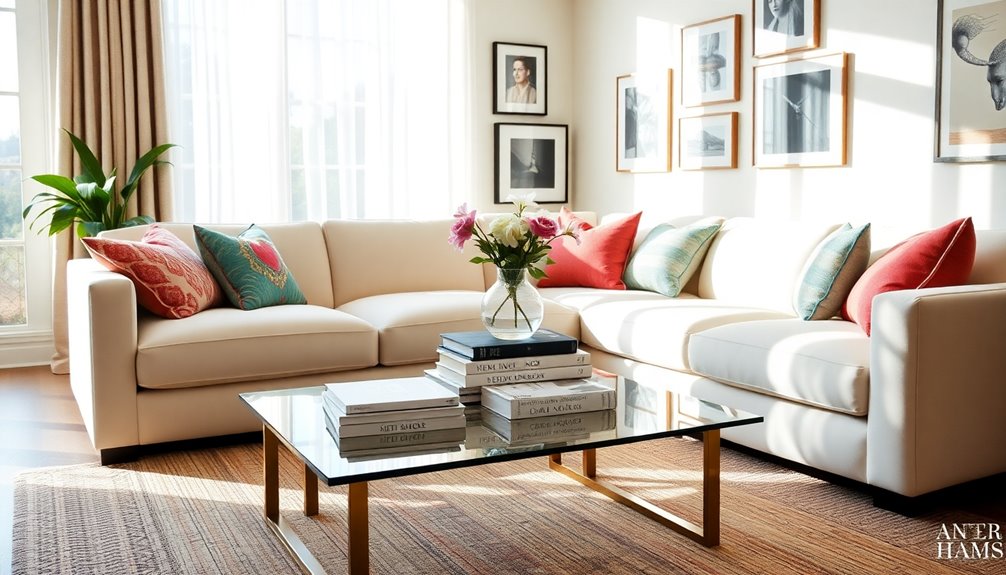To perfect your space’s final look, start with color selection—mix various shades and remember to test them in different lighting. Next, blend materials by pairing warm woods with cool metals for contrast. For impactful wall treatments, oversized art can define height while unique wallpapers alter perceptions. When arranging furniture, opt for diverse styles to create focal points and guarantee flow. Finally, choose the right rug size to link your furniture together comfortably. Each of these tricks adds depth and character, and there’s more to discover that can transform your space beautifully. To complete the look, don’t forget to incorporate elegant space essentials like statement lighting fixtures and luxurious textiles. These finishing touches will elevate the overall ambiance of the room and make it feel more inviting and sophisticated. Pay attention to small details like decorative accents and carefully chosen accessories to add a personal touch and tie the room together seamlessly.
Key Takeaways
- Utilize diverse color palettes, incorporating various shades and contrasting hues to enhance visual depth and interest.
- Mix materials thoughtfully, such as pairing honey-toned hardwood with metal accents for a balance of warmth and coolness.
- Apply impactful wall treatments like oversized art or textured wallpaper to redefine space perception and create focal points.
- Embrace dynamic furniture pairing by mixing styles and shapes to introduce character and ensure functional arrangement.
- Choose appropriately sized rugs that unify furniture arrangements, ensuring they provide a cohesive and grounded feel in the space.
Color Selection Strategies
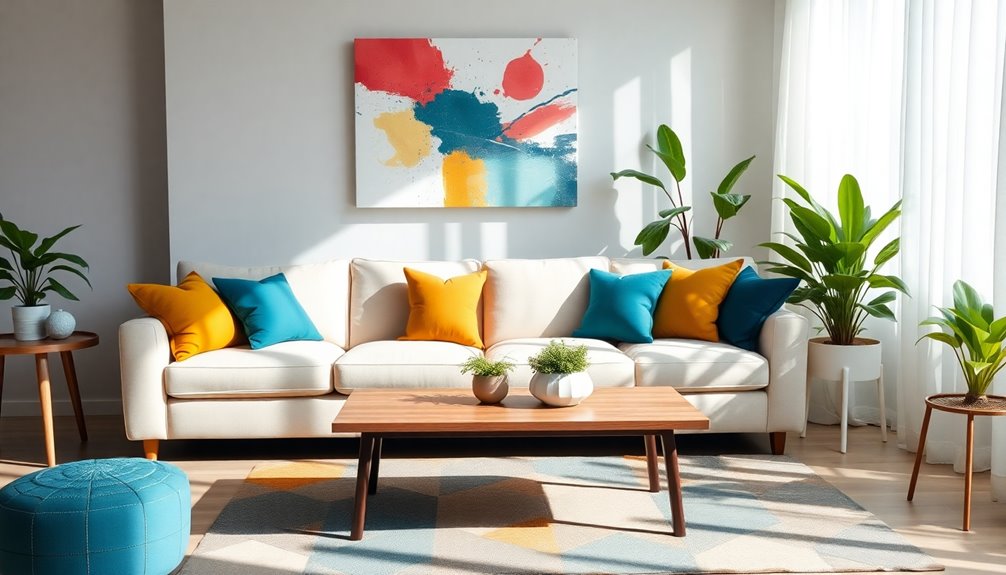
When you're selecting colors for your space, remember that a diverse palette can create depth and interest, rather than sticking to a single hue. In your living room, use various shades, tones, and tints to develop a layered look. Instead of relying on monochromatic schemes, incorporate contrasting colors that make elements pop and enhance visual appeal.
To enhance the calming atmosphere, consider using earthy color palettes that reflect the warm and serene vibes typical in Balinese design. Pay attention to lighting; it can dramatically change how colors are perceived throughout the day. Natural and artificial light can alter the mood and appearance of your chosen colors, so test them in different conditions before committing. Additionally, consider how different lighting solutions can enhance the overall aesthetic of your color choices. Understanding lighting design principles can further improve the way your colors interact in the space.
Explore color theory principles, such as complementary and analogous combinations, to achieve designs that harmonize beautifully with your overall theme. For instance, pairing a warm beige with a cool navy can create a striking contrast that feels both inviting and dynamic.
Avoid matching colors too closely; instead, opt for variations that offer a more engaging environment. Utilizing these color selection strategies won't only elevate your living room but also create a space that feels cohesive and thoughtfully designed. Incorporating earthy shades into your color palette can enhance the cozy ambiance reminiscent of a farmhouse kitchen.
Let your creativity flow and enjoy the process of transforming your space with color!
Effective Material Mixing
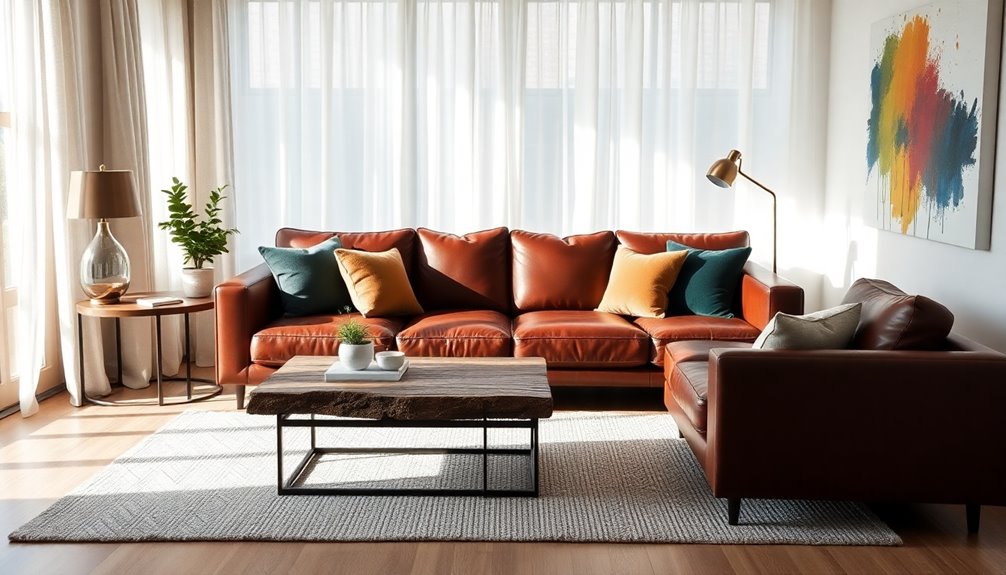
Mixing materials effectively can transform your space, adding depth and character. To achieve this, make certain you consider the balance between different elements.
For instance, pairing honey-toned hardwood floors with a blonde console and deep mahogany accents creates a striking contrast that draws the eye. Avoid sticking to conventional matches; instead, mix cool metals, like stainless steel, with warm metals such as brass. This enhances visual variety and keeps your design fresh.
Start with mixing finishes within the same family to build confidence. As you grow more comfortable, gradually introduce diverse materials like matte and glossy textures. This layering adds richness and prevents a flat appearance. Incorporating textured fabrics can further enhance the warmth and comfort of your mixed materials. You might consider sourcing unique pieces from Balinese furniture to add an authentic tropical touch to your design. Additionally, consider incorporating natural materials like reclaimed wood to evoke a modern farmhouse aesthetic that complements your overall theme.
To maintain harmony, ascertain that the scale and proportion of your mixed materials complement each other. A well-thought-out combination will create a cohesive look rather than a jarring contrast. Additionally, consider how urban themes can inspire your material choices, reflecting a dynamic interplay of tradition and modernity in your design.
Impactful Wall Treatments
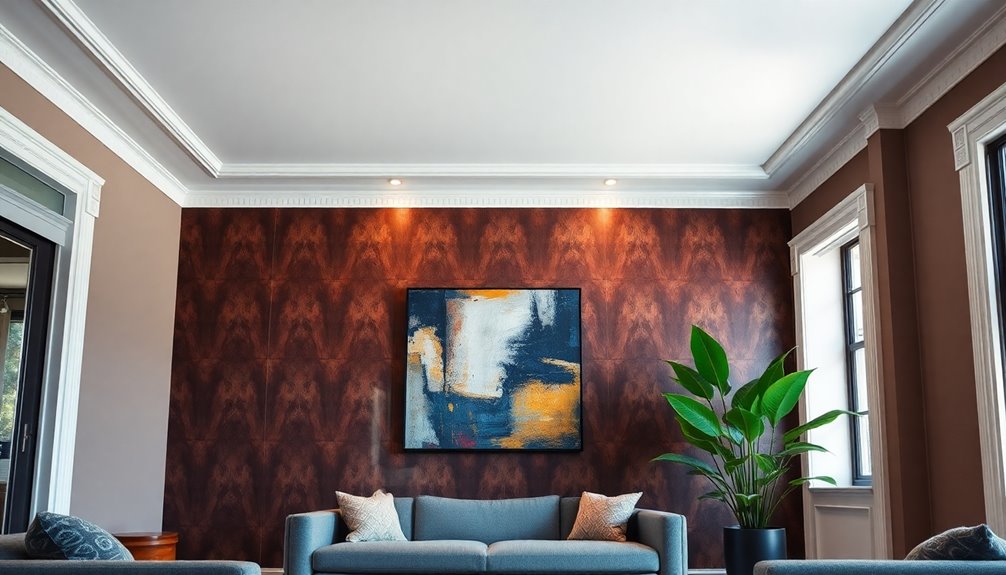
Incorporating impactful wall treatments can elevate your space just as effectively as mixing materials does. In your dining room, oversized art pieces should be a priority. They create a notable visual impact and help define the room's height, making the space feel grander. When you hang artwork, aim for pieces that are about two-thirds the width of your sofa for a balanced look.
Consider wall treatments like wallpaper or textured finishes to dramatically alter how your dining room feels. These treatments add depth and character, transforming the perception of size and shape. To avoid blank walls that detract from a finished look, think about creating a gallery wall or placing a series of well-curated artworks that align with your dining room's theme.
Additionally, selecting wall colors that contrast with your furniture can enhance the overall aesthetic. This creates a dynamic and engaging atmosphere that draws guests into your space. Furthermore, using neutral color palettes from the modern farmhouse style can create a warm and inviting ambiance.
Dynamic Furniture Pairing
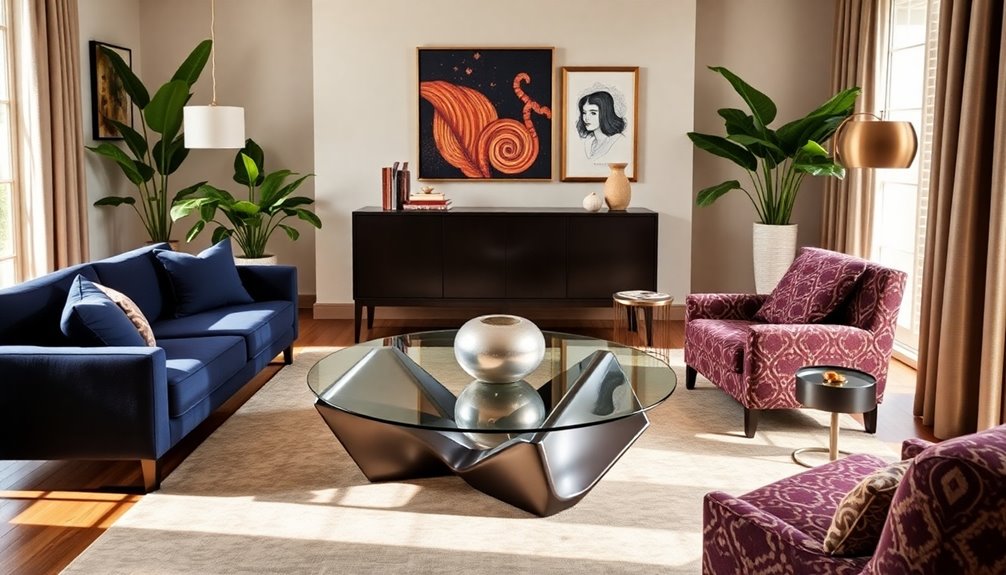
Dynamic furniture pairing can transform your space from ordinary to extraordinary. Instead of sticking with matching furniture sets, mix contrasting styles and shapes. For example, pair a modern sofa with a vintage coffee table for an eye-catching look. This approach adds character and creates a unique focal point in the room.
Incorporate diverse lines and forms by combining pieces of varying heights and silhouettes. This not only adds interest but also depth, making the room feel more dynamic. Mixing materials, like wood and metal finishes, prevents a flat appearance and enhances texture throughout the space.
When arranging your furniture, think about flow and functionality. Make certain that your pieces complement each other while allowing easy movement around the room.
Layering furniture can also create an engaging look; position a sleek console table behind a plush sectional sofa to introduce balance and visual intrigue.
Proper Rug Sizing
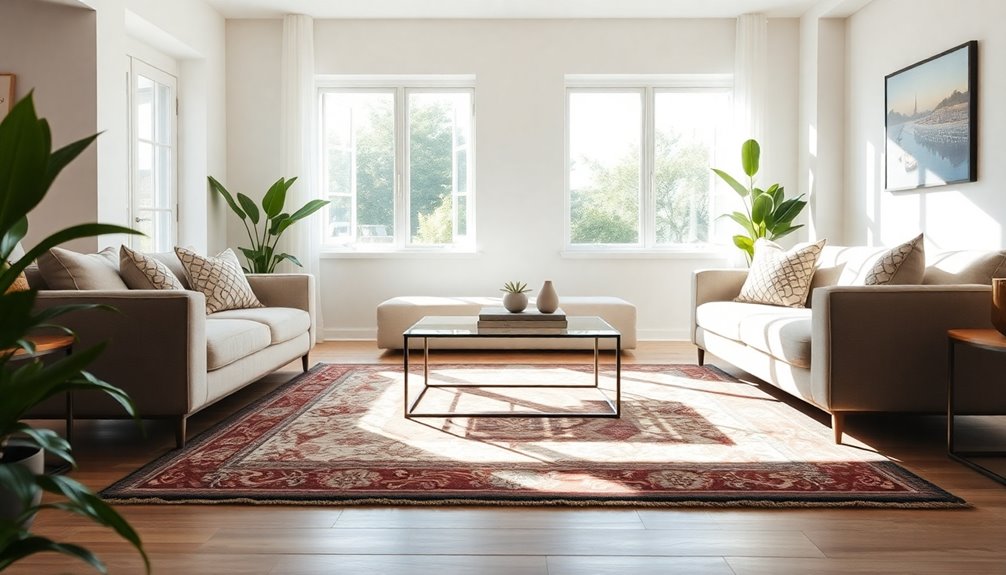
Rugs can make or break a room's design, so getting the sizing right is essential. A well-sized rug can unify your space, while a too-small one can leave it feeling disjointed.
Here are some tips to guarantee you choose the perfect rug size:
- Make sure at least the front legs of your sofas and chairs rest on the rug to create a cohesive look.
- In dining areas, opt for a rug that allows all four legs of the dining chairs to fit comfortably, defining the space beautifully.
- Consider the scale of your furniture; a larger rug can make your room feel more spacious and grounded.
- For unique spaces, don't hesitate to go back and explore custom-cut rugs that can provide the perfect fit.
- Avoid small rugs that can detract from the overall design, making your room feel incomplete.
Additionally, remember that the right rug size can enhance the overall aesthetics of your room and contribute to a more inviting atmosphere.
Frequently Asked Questions
What Is the 3-5-7 Rule in Decorating?
The 3-5-7 rule in decorating suggests you arrange objects in groups of three, five, or seven. This approach creates a visually appealing balance and harmony in your space.
When you group items, vary their heights and shapes to add interest. Don't forget to mix textures, colors, and materials for a cohesive look.
Always consider the scale of your objects to avoid overcrowding, ensuring a polished and inviting atmosphere in your home.
What Is the 2/3 Rule Sofa?
The 2/3 rule for sofa art placement suggests that the artwork above your sofa should span about two-thirds of the sofa's width.
This creates a balanced visual effect, making the art feel proportionate and connected to your furniture.
For instance, if your sofa is 72 inches wide, aim for artwork around 48 inches wide.
How to Make Your Lounge Look Expensive?
Did you know that 68% of people believe a well-decorated home enhances their mood?
To make your lounge look expensive, mix a diverse color palette with contrasting shades for depth. Invest in oversized artwork that complements your furniture and layer materials like warm woods with cool metals for richness.
Choose a suitably sized rug to define your seating area, and avoid matching furniture sets to create a dynamic, sophisticated atmosphere.
What Are the 7 Rules of Interior Design?
When you're diving into interior design, remember these seven rules: balance creates harmony, while the rule of three makes arrangements visually appealing.
Pay attention to scale and proportion, ensuring your furniture fits the space. Use color theory to establish a cohesive palette, and define focal points to draw the eye.
Finally, don't forget about functionality; your space should be as practical as it's beautiful.
Following these guidelines will elevate your design game!
